University of Mumbai MMS Project: Retailing Impact on Indian Economy
VerifiedAdded on 2022/03/17
|36
|6831
|40
Project
AI Summary
This project report, submitted to the University of Mumbai for the Master of Management Studies (MMS) degree, investigates the impact of the Indian retail industry on the national economy during the academic year 2016-2017. The study provides an overview of the retail sector, including organized and unorganized retail formats, market size, investment scenarios, and government initiatives. It analyzes the influence of e-commerce, changing consumer behavior, and foreign direct investment (FDI) on the growth of the retail industry. The report also examines the sector's contribution to the GDP and employment, along with future trends and opportunities. It also includes an executive summary, sector overview, analysis of key areas such as e-commerce, and suggestions to improve the sector. The project highlights the dynamic and fast-paced nature of the Indian retail industry, its growth potential, and its significant role in the overall economic landscape.
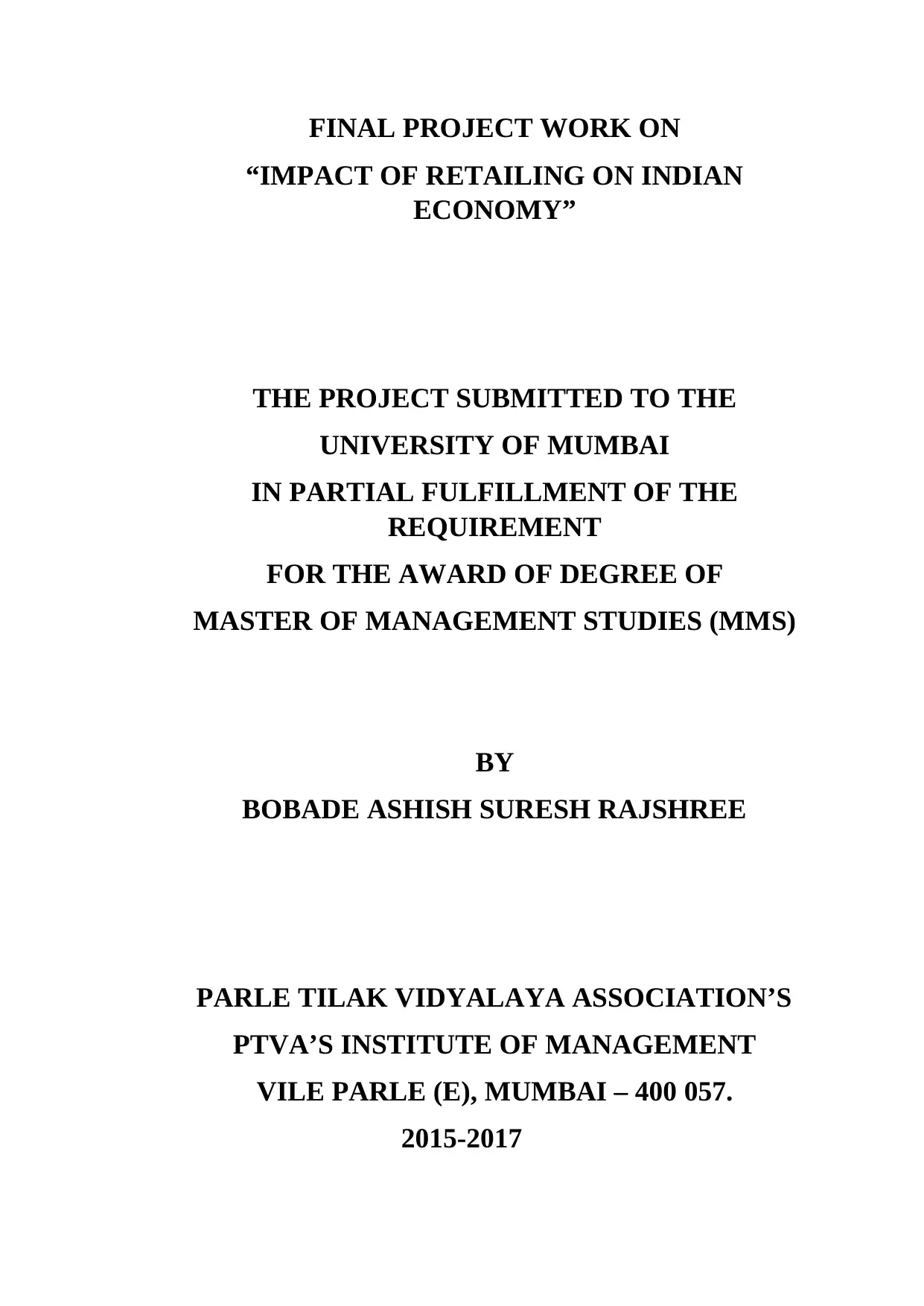
FINAL PROJECT WORK ON
“IMPACT OF RETAILING ON INDIAN
ECONOMY”
THE PROJECT SUBMITTED TO THE
UNIVERSITY OF MUMBAI
IN PARTIAL FULFILLMENT OF THE
REQUIREMENT
FOR THE AWARD OF DEGREE OF
MASTER OF MANAGEMENT STUDIES (MMS)
BY
BOBADE ASHISH SURESH RAJSHREE
PARLE TILAK VIDYALAYA ASSOCIATION’S
PTVA’S INSTITUTE OF MANAGEMENT
VILE PARLE (E), MUMBAI – 400 057.
2015-2017
“IMPACT OF RETAILING ON INDIAN
ECONOMY”
THE PROJECT SUBMITTED TO THE
UNIVERSITY OF MUMBAI
IN PARTIAL FULFILLMENT OF THE
REQUIREMENT
FOR THE AWARD OF DEGREE OF
MASTER OF MANAGEMENT STUDIES (MMS)
BY
BOBADE ASHISH SURESH RAJSHREE
PARLE TILAK VIDYALAYA ASSOCIATION’S
PTVA’S INSTITUTE OF MANAGEMENT
VILE PARLE (E), MUMBAI – 400 057.
2015-2017
Paraphrase This Document
Need a fresh take? Get an instant paraphrase of this document with our AI Paraphraser
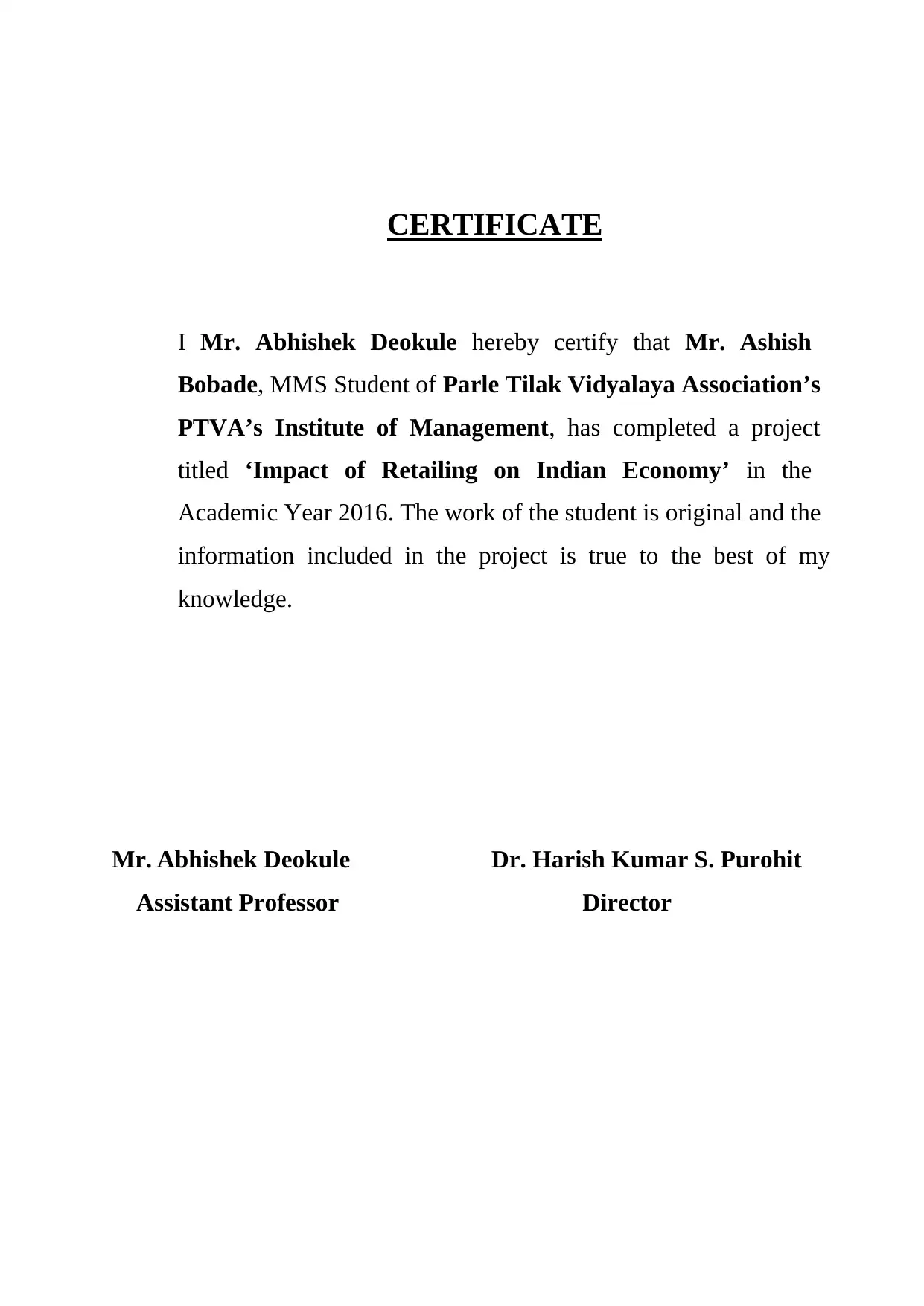
CERTIFICATE
I Mr. Abhishek Deokule hereby certify that Mr. Ashish
Bobade, MMS Student of Parle Tilak Vidyalaya Association’s
PTVA’s Institute of Management, has completed a project
titled ‘Impact of Retailing on Indian Economy’ in the
Academic Year 2016. The work of the student is original and the
information included in the project is true to the best of my
knowledge.
Mr. Abhishek Deokule Dr. Harish Kumar S. Purohit
Assistant Professor Director
I Mr. Abhishek Deokule hereby certify that Mr. Ashish
Bobade, MMS Student of Parle Tilak Vidyalaya Association’s
PTVA’s Institute of Management, has completed a project
titled ‘Impact of Retailing on Indian Economy’ in the
Academic Year 2016. The work of the student is original and the
information included in the project is true to the best of my
knowledge.
Mr. Abhishek Deokule Dr. Harish Kumar S. Purohit
Assistant Professor Director
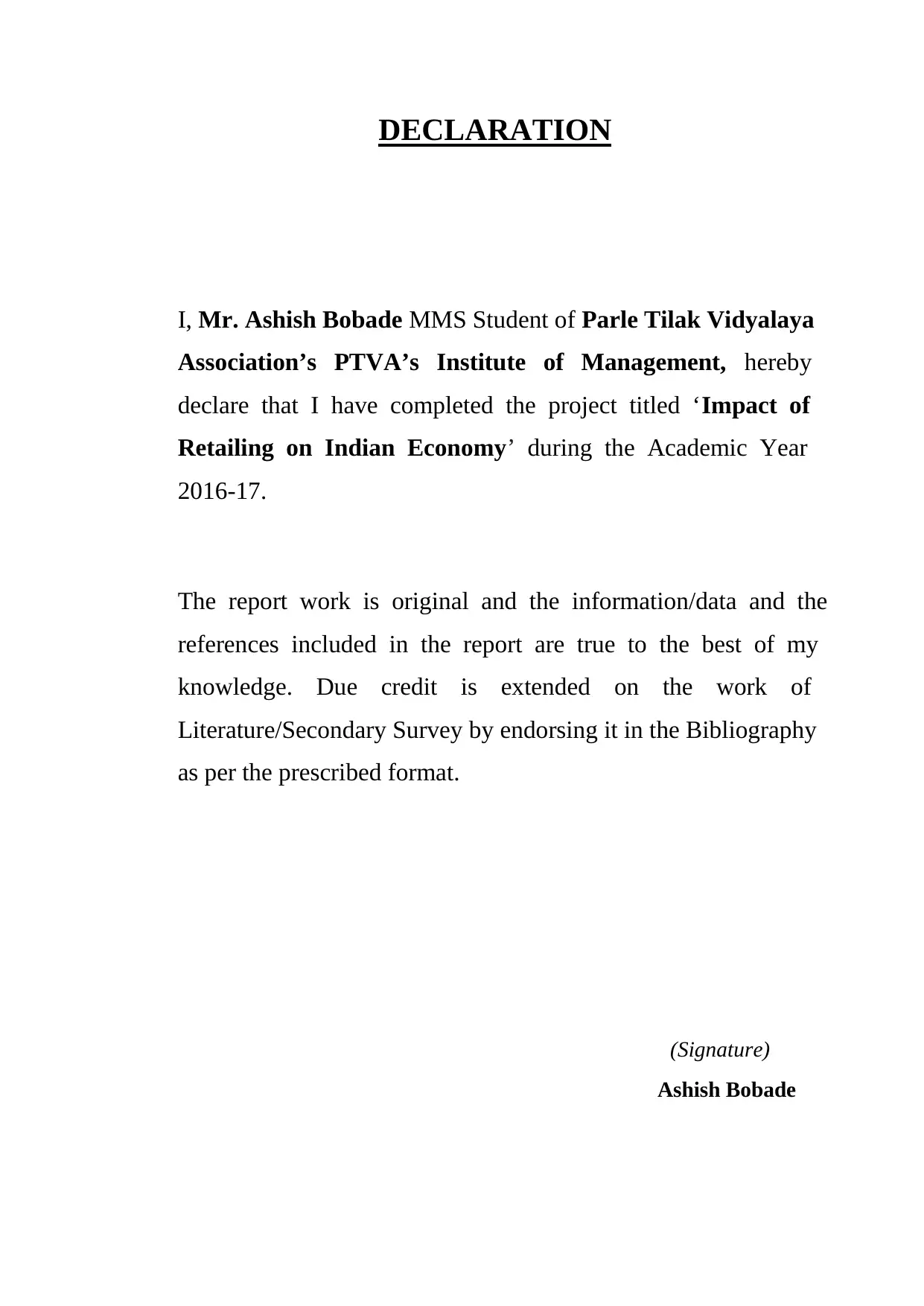
DECLARATION
I, Mr. Ashish Bobade MMS Student of Parle Tilak Vidyalaya
Association’s PTVA’s Institute of Management, hereby
declare that I have completed the project titled ‘Impact of
Retailing on Indian Economy’ during the Academic Year
2016-17.
The report work is original and the information/data and the
references included in the report are true to the best of my
knowledge. Due credit is extended on the work of
Literature/Secondary Survey by endorsing it in the Bibliography
as per the prescribed format.
(Signature)
Ashish Bobade
I, Mr. Ashish Bobade MMS Student of Parle Tilak Vidyalaya
Association’s PTVA’s Institute of Management, hereby
declare that I have completed the project titled ‘Impact of
Retailing on Indian Economy’ during the Academic Year
2016-17.
The report work is original and the information/data and the
references included in the report are true to the best of my
knowledge. Due credit is extended on the work of
Literature/Secondary Survey by endorsing it in the Bibliography
as per the prescribed format.
(Signature)
Ashish Bobade
⊘ This is a preview!⊘
Do you want full access?
Subscribe today to unlock all pages.

Trusted by 1+ million students worldwide
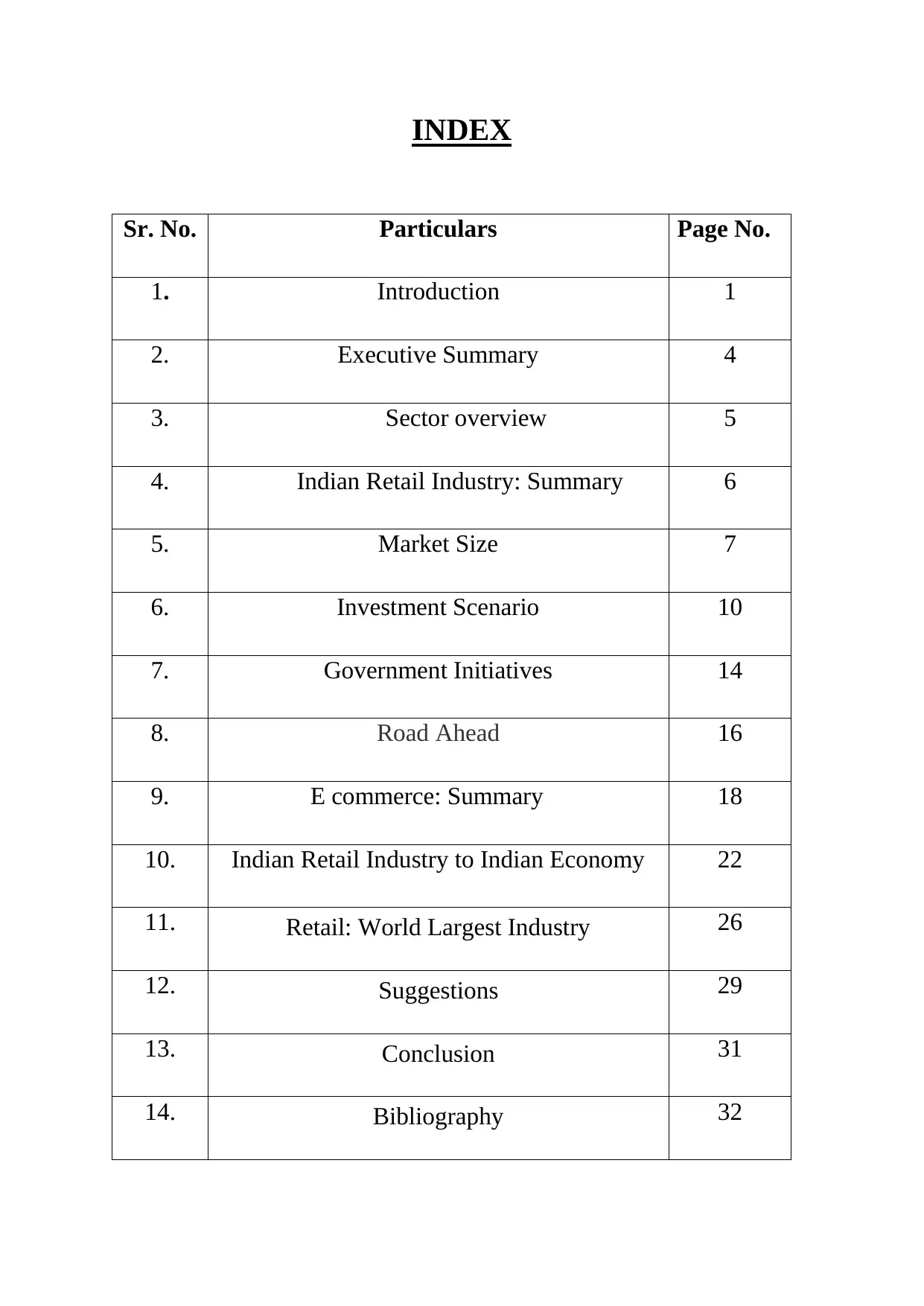
INDEX
Sr. No. Particulars Page No.
1. Introduction 1
2. Executive Summary 4
3. Sector overview 5
4. Indian Retail Industry: Summary 6
5. Market Size 7
6. Investment Scenario 10
7. Government Initiatives 14
8. Road Ahead 16
9. E commerce: Summary 18
10. Indian Retail Industry to Indian Economy 22
11. Retail: World Largest Industry 26
12. Suggestions 29
13. Conclusion 31
14. Bibliography 32
Sr. No. Particulars Page No.
1. Introduction 1
2. Executive Summary 4
3. Sector overview 5
4. Indian Retail Industry: Summary 6
5. Market Size 7
6. Investment Scenario 10
7. Government Initiatives 14
8. Road Ahead 16
9. E commerce: Summary 18
10. Indian Retail Industry to Indian Economy 22
11. Retail: World Largest Industry 26
12. Suggestions 29
13. Conclusion 31
14. Bibliography 32
Paraphrase This Document
Need a fresh take? Get an instant paraphrase of this document with our AI Paraphraser
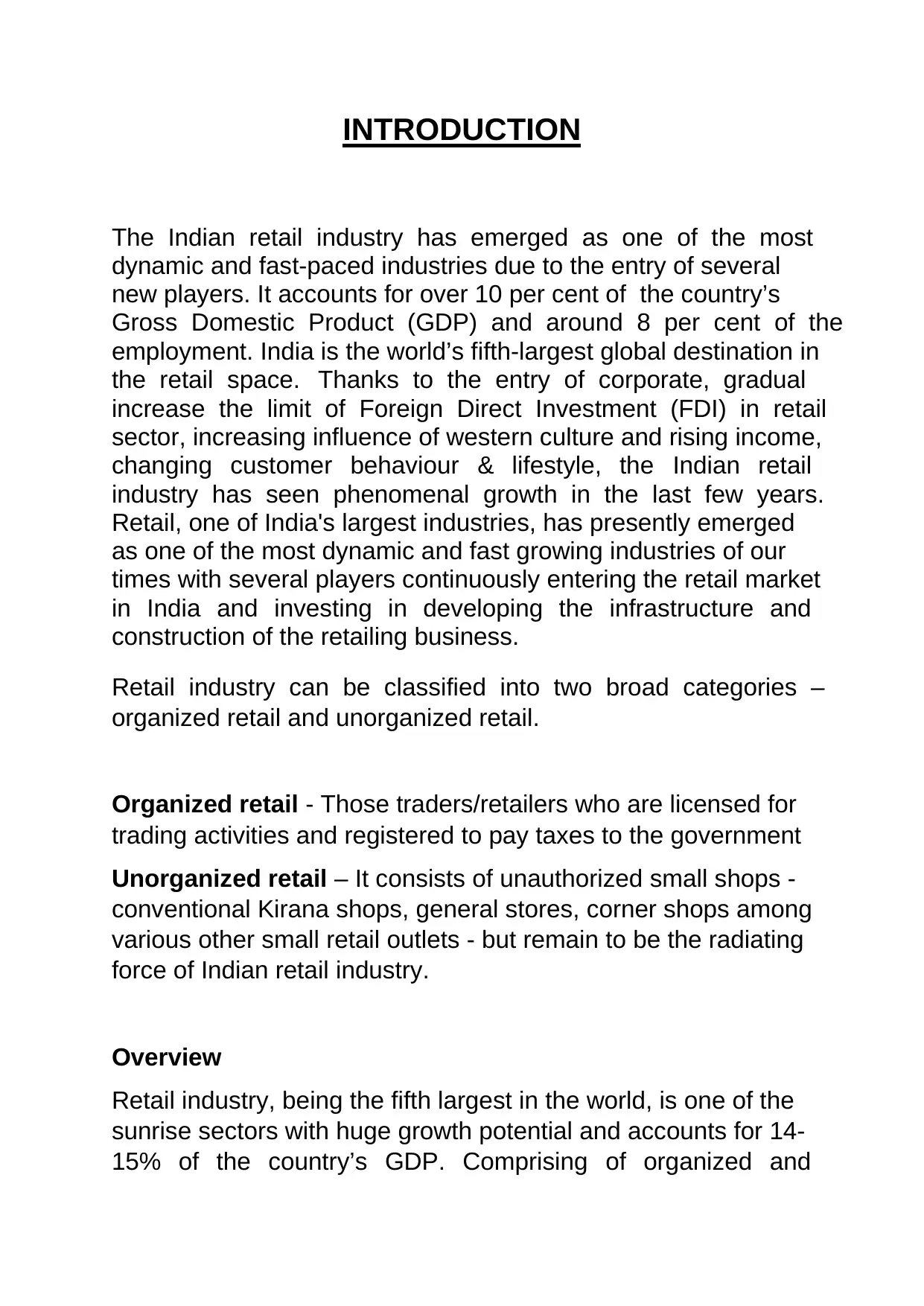
INTRODUCTION
The Indian retail industry has emerged as one of the most
dynamic and fast-paced industries due to the entry of several
new players. It accounts for over 10 per cent of the country’s
Gross Domestic Product (GDP) and around 8 per cent of the
employment. India is the world’s fifth-largest global destination in
the retail space. Thanks to the entry of corporate, gradual
increase the limit of Foreign Direct Investment (FDI) in retail
sector, increasing influence of western culture and rising income,
changing customer behaviour & lifestyle, the Indian retail
industry has seen phenomenal growth in the last few years.
Retail, one of India's largest industries, has presently emerged
as one of the most dynamic and fast growing industries of our
times with several players continuously entering the retail market
in India and investing in developing the infrastructure and
construction of the retailing business.
Retail industry can be classified into two broad categories –
organized retail and unorganized retail.
Organized retail - Those traders/retailers who are licensed for
trading activities and registered to pay taxes to the government
Unorganized retail – It consists of unauthorized small shops -
conventional Kirana shops, general stores, corner shops among
various other small retail outlets - but remain to be the radiating
force of Indian retail industry.
Overview
Retail industry, being the fifth largest in the world, is one of the
sunrise sectors with huge growth potential and accounts for 14-
15% of the country’s GDP. Comprising of organized and
The Indian retail industry has emerged as one of the most
dynamic and fast-paced industries due to the entry of several
new players. It accounts for over 10 per cent of the country’s
Gross Domestic Product (GDP) and around 8 per cent of the
employment. India is the world’s fifth-largest global destination in
the retail space. Thanks to the entry of corporate, gradual
increase the limit of Foreign Direct Investment (FDI) in retail
sector, increasing influence of western culture and rising income,
changing customer behaviour & lifestyle, the Indian retail
industry has seen phenomenal growth in the last few years.
Retail, one of India's largest industries, has presently emerged
as one of the most dynamic and fast growing industries of our
times with several players continuously entering the retail market
in India and investing in developing the infrastructure and
construction of the retailing business.
Retail industry can be classified into two broad categories –
organized retail and unorganized retail.
Organized retail - Those traders/retailers who are licensed for
trading activities and registered to pay taxes to the government
Unorganized retail – It consists of unauthorized small shops -
conventional Kirana shops, general stores, corner shops among
various other small retail outlets - but remain to be the radiating
force of Indian retail industry.
Overview
Retail industry, being the fifth largest in the world, is one of the
sunrise sectors with huge growth potential and accounts for 14-
15% of the country’s GDP. Comprising of organized and
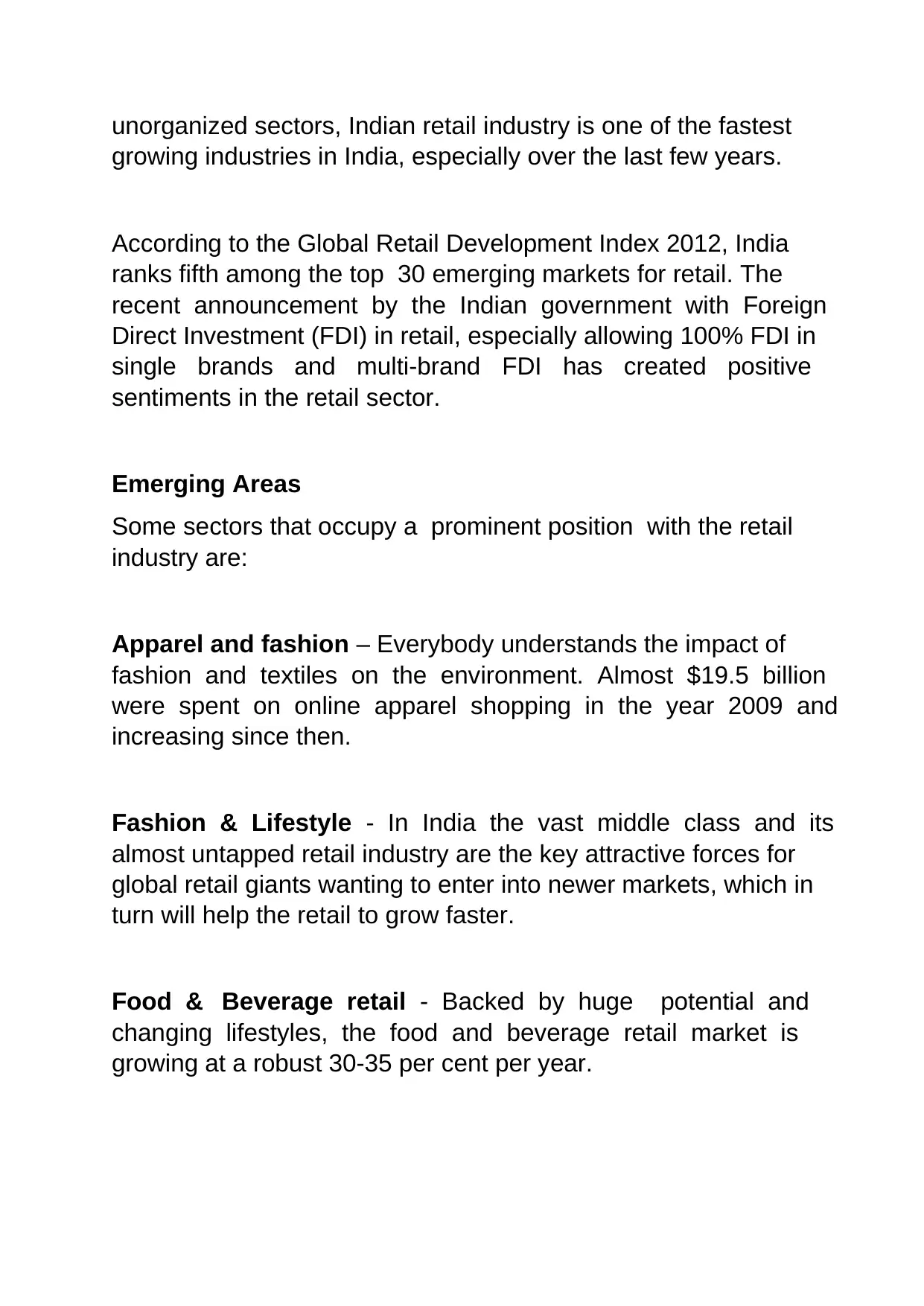
unorganized sectors, Indian retail industry is one of the fastest
growing industries in India, especially over the last few years.
According to the Global Retail Development Index 2012, India
ranks fifth among the top 30 emerging markets for retail. The
recent announcement by the Indian government with Foreign
Direct Investment (FDI) in retail, especially allowing 100% FDI in
single brands and multi-brand FDI has created positive
sentiments in the retail sector.
Emerging Areas
Some sectors that occupy a prominent position with the retail
industry are:
Apparel and fashion – Everybody understands the impact of
fashion and textiles on the environment. Almost $19.5 billion
were spent on online apparel shopping in the year 2009 and
increasing since then.
Fashion & Lifestyle - In India the vast middle class and its
almost untapped retail industry are the key attractive forces for
global retail giants wanting to enter into newer markets, which in
turn will help the retail to grow faster.
Food & Beverage retail - Backed by huge potential and
changing lifestyles, the food and beverage retail market is
growing at a robust 30-35 per cent per year.
growing industries in India, especially over the last few years.
According to the Global Retail Development Index 2012, India
ranks fifth among the top 30 emerging markets for retail. The
recent announcement by the Indian government with Foreign
Direct Investment (FDI) in retail, especially allowing 100% FDI in
single brands and multi-brand FDI has created positive
sentiments in the retail sector.
Emerging Areas
Some sectors that occupy a prominent position with the retail
industry are:
Apparel and fashion – Everybody understands the impact of
fashion and textiles on the environment. Almost $19.5 billion
were spent on online apparel shopping in the year 2009 and
increasing since then.
Fashion & Lifestyle - In India the vast middle class and its
almost untapped retail industry are the key attractive forces for
global retail giants wanting to enter into newer markets, which in
turn will help the retail to grow faster.
Food & Beverage retail - Backed by huge potential and
changing lifestyles, the food and beverage retail market is
growing at a robust 30-35 per cent per year.
⊘ This is a preview!⊘
Do you want full access?
Subscribe today to unlock all pages.

Trusted by 1+ million students worldwide
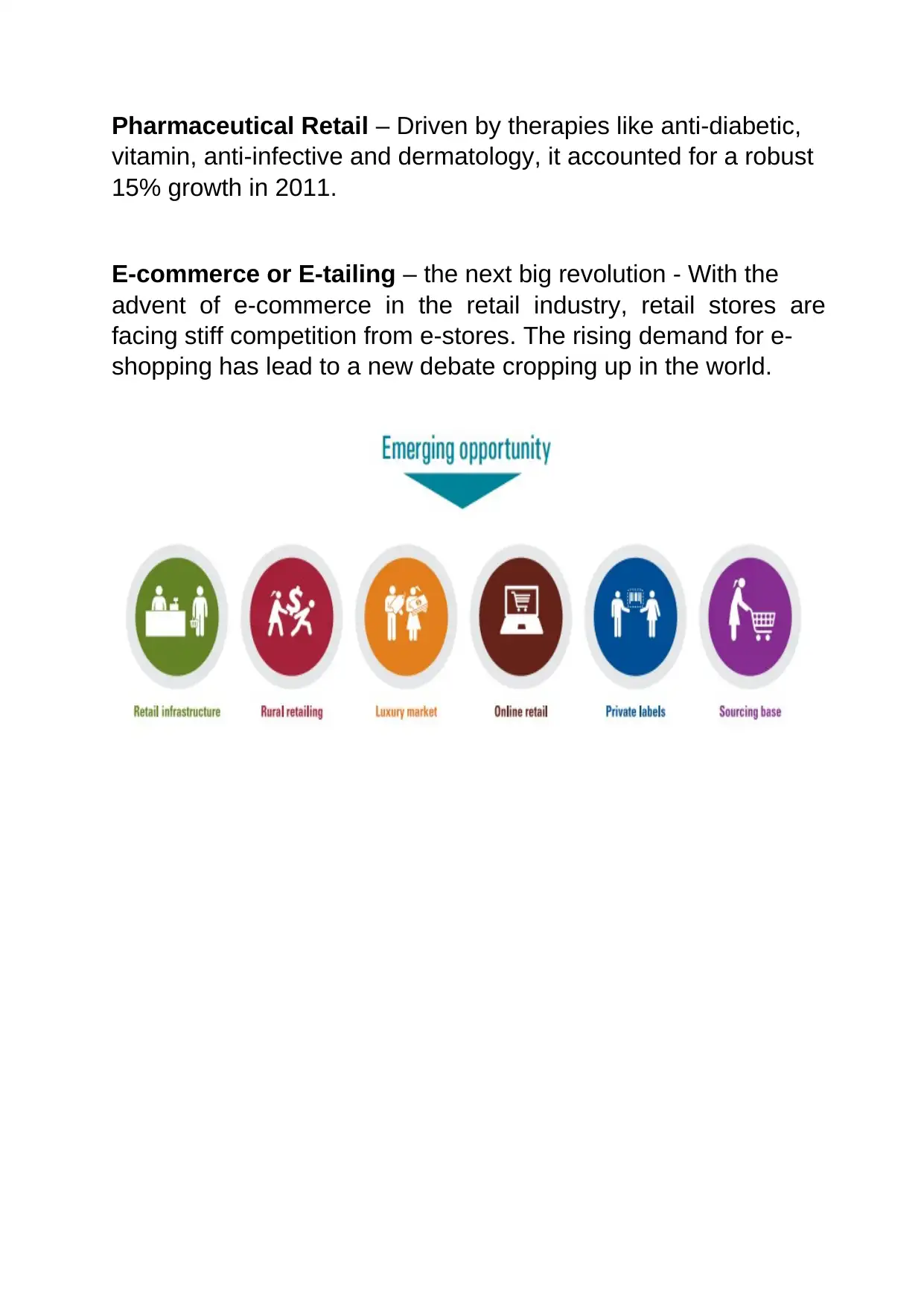
Pharmaceutical Retail – Driven by therapies like anti-diabetic,
vitamin, anti-infective and dermatology, it accounted for a robust
15% growth in 2011.
E-commerce or E-tailing – the next big revolution - With the
advent of e-commerce in the retail industry, retail stores are
facing stiff competition from e-stores. The rising demand for e-
shopping has lead to a new debate cropping up in the world.
vitamin, anti-infective and dermatology, it accounted for a robust
15% growth in 2011.
E-commerce or E-tailing – the next big revolution - With the
advent of e-commerce in the retail industry, retail stores are
facing stiff competition from e-stores. The rising demand for e-
shopping has lead to a new debate cropping up in the world.
Paraphrase This Document
Need a fresh take? Get an instant paraphrase of this document with our AI Paraphraser
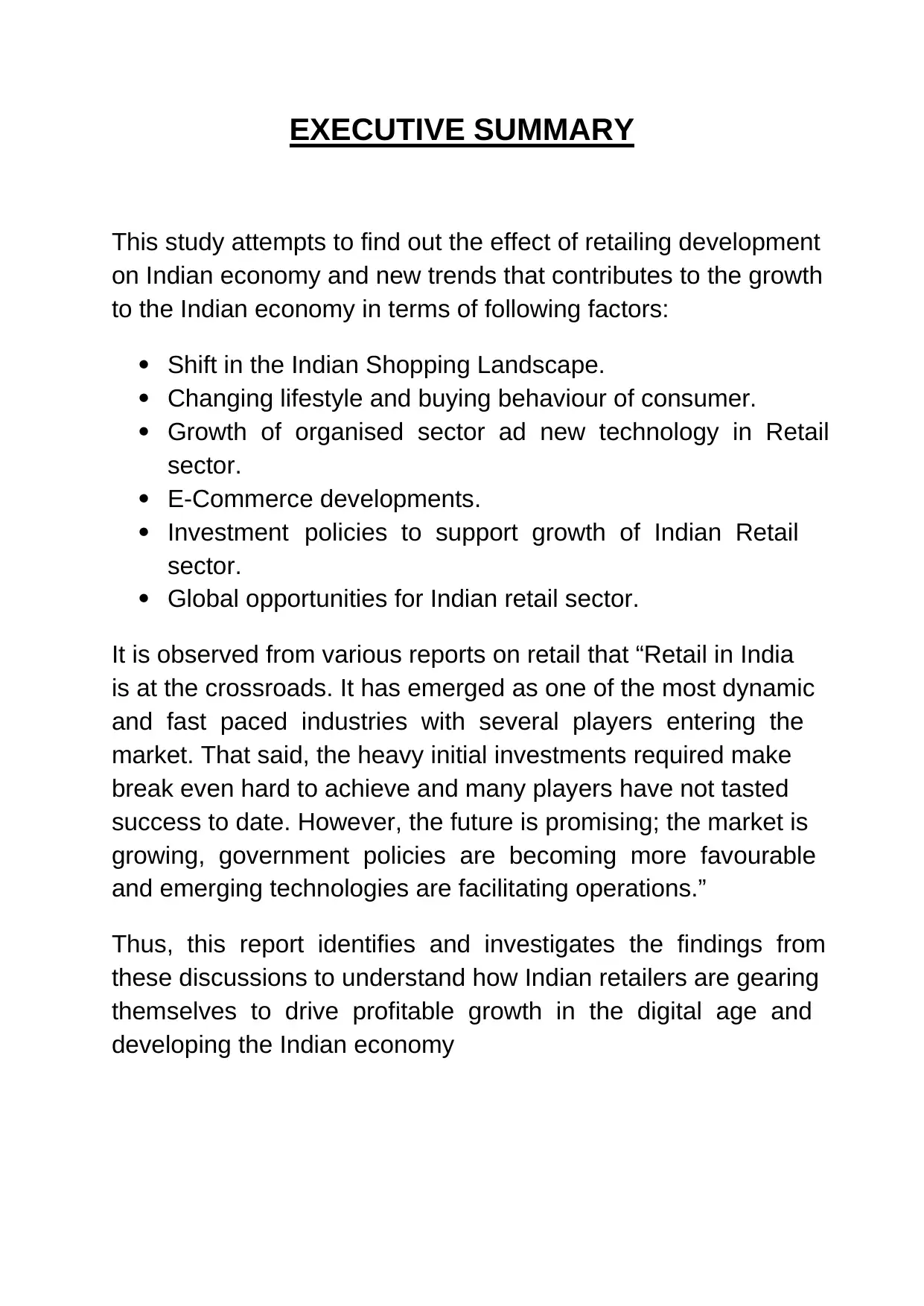
EXECUTIVE SUMMARY
This study attempts to find out the effect of retailing development
on Indian economy and new trends that contributes to the growth
to the Indian economy in terms of following factors:
Shift in the Indian Shopping Landscape.
Changing lifestyle and buying behaviour of consumer.
Growth of organised sector ad new technology in Retail
sector.
E-Commerce developments.
Investment policies to support growth of Indian Retail
sector.
Global opportunities for Indian retail sector.
It is observed from various reports on retail that “Retail in India
is at the crossroads. It has emerged as one of the most dynamic
and fast paced industries with several players entering the
market. That said, the heavy initial investments required make
break even hard to achieve and many players have not tasted
success to date. However, the future is promising; the market is
growing, government policies are becoming more favourable
and emerging technologies are facilitating operations.”
Thus, this report identifies and investigates the findings from
these discussions to understand how Indian retailers are gearing
themselves to drive profitable growth in the digital age and
developing the Indian economy
This study attempts to find out the effect of retailing development
on Indian economy and new trends that contributes to the growth
to the Indian economy in terms of following factors:
Shift in the Indian Shopping Landscape.
Changing lifestyle and buying behaviour of consumer.
Growth of organised sector ad new technology in Retail
sector.
E-Commerce developments.
Investment policies to support growth of Indian Retail
sector.
Global opportunities for Indian retail sector.
It is observed from various reports on retail that “Retail in India
is at the crossroads. It has emerged as one of the most dynamic
and fast paced industries with several players entering the
market. That said, the heavy initial investments required make
break even hard to achieve and many players have not tasted
success to date. However, the future is promising; the market is
growing, government policies are becoming more favourable
and emerging technologies are facilitating operations.”
Thus, this report identifies and investigates the findings from
these discussions to understand how Indian retailers are gearing
themselves to drive profitable growth in the digital age and
developing the Indian economy
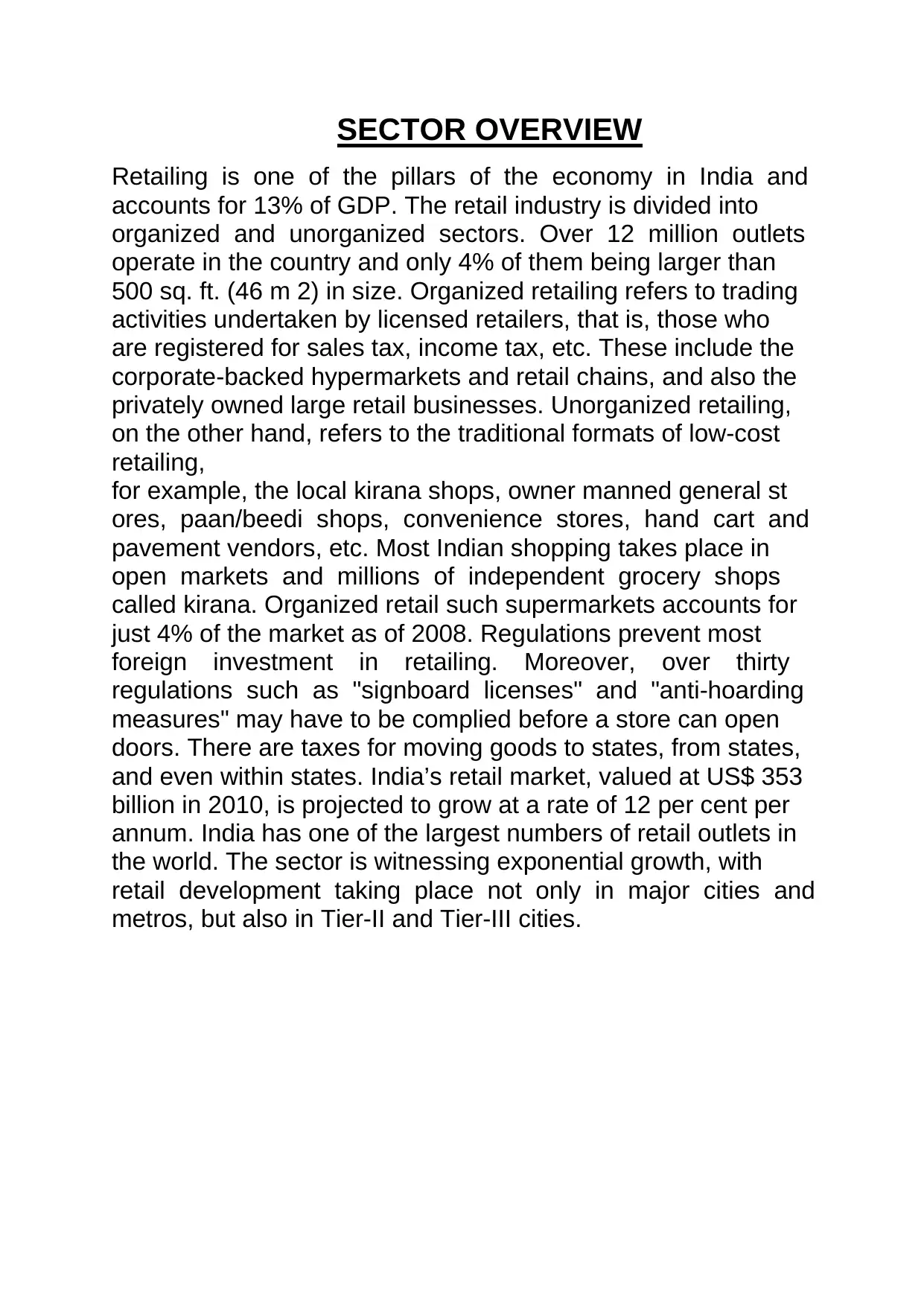
SECTOR OVERVIEW
Retailing is one of the pillars of the economy in India and
accounts for 13% of GDP. The retail industry is divided into
organized and unorganized sectors. Over 12 million outlets
operate in the country and only 4% of them being larger than
500 sq. ft. (46 m 2) in size. Organized retailing refers to trading
activities undertaken by licensed retailers, that is, those who
are registered for sales tax, income tax, etc. These include the
corporate-backed hypermarkets and retail chains, and also the
privately owned large retail businesses. Unorganized retailing,
on the other hand, refers to the traditional formats of low-cost
retailing,
for example, the local kirana shops, owner manned general st
ores, paan/beedi shops, convenience stores, hand cart and
pavement vendors, etc. Most Indian shopping takes place in
open markets and millions of independent grocery shops
called kirana. Organized retail such supermarkets accounts for
just 4% of the market as of 2008. Regulations prevent most
foreign investment in retailing. Moreover, over thirty
regulations such as "signboard licenses" and "anti-hoarding
measures" may have to be complied before a store can open
doors. There are taxes for moving goods to states, from states,
and even within states. India’s retail market, valued at US$ 353
billion in 2010, is projected to grow at a rate of 12 per cent per
annum. India has one of the largest numbers of retail outlets in
the world. The sector is witnessing exponential growth, with
retail development taking place not only in major cities and
metros, but also in Tier-II and Tier-III cities.
Retailing is one of the pillars of the economy in India and
accounts for 13% of GDP. The retail industry is divided into
organized and unorganized sectors. Over 12 million outlets
operate in the country and only 4% of them being larger than
500 sq. ft. (46 m 2) in size. Organized retailing refers to trading
activities undertaken by licensed retailers, that is, those who
are registered for sales tax, income tax, etc. These include the
corporate-backed hypermarkets and retail chains, and also the
privately owned large retail businesses. Unorganized retailing,
on the other hand, refers to the traditional formats of low-cost
retailing,
for example, the local kirana shops, owner manned general st
ores, paan/beedi shops, convenience stores, hand cart and
pavement vendors, etc. Most Indian shopping takes place in
open markets and millions of independent grocery shops
called kirana. Organized retail such supermarkets accounts for
just 4% of the market as of 2008. Regulations prevent most
foreign investment in retailing. Moreover, over thirty
regulations such as "signboard licenses" and "anti-hoarding
measures" may have to be complied before a store can open
doors. There are taxes for moving goods to states, from states,
and even within states. India’s retail market, valued at US$ 353
billion in 2010, is projected to grow at a rate of 12 per cent per
annum. India has one of the largest numbers of retail outlets in
the world. The sector is witnessing exponential growth, with
retail development taking place not only in major cities and
metros, but also in Tier-II and Tier-III cities.
⊘ This is a preview!⊘
Do you want full access?
Subscribe today to unlock all pages.

Trusted by 1+ million students worldwide
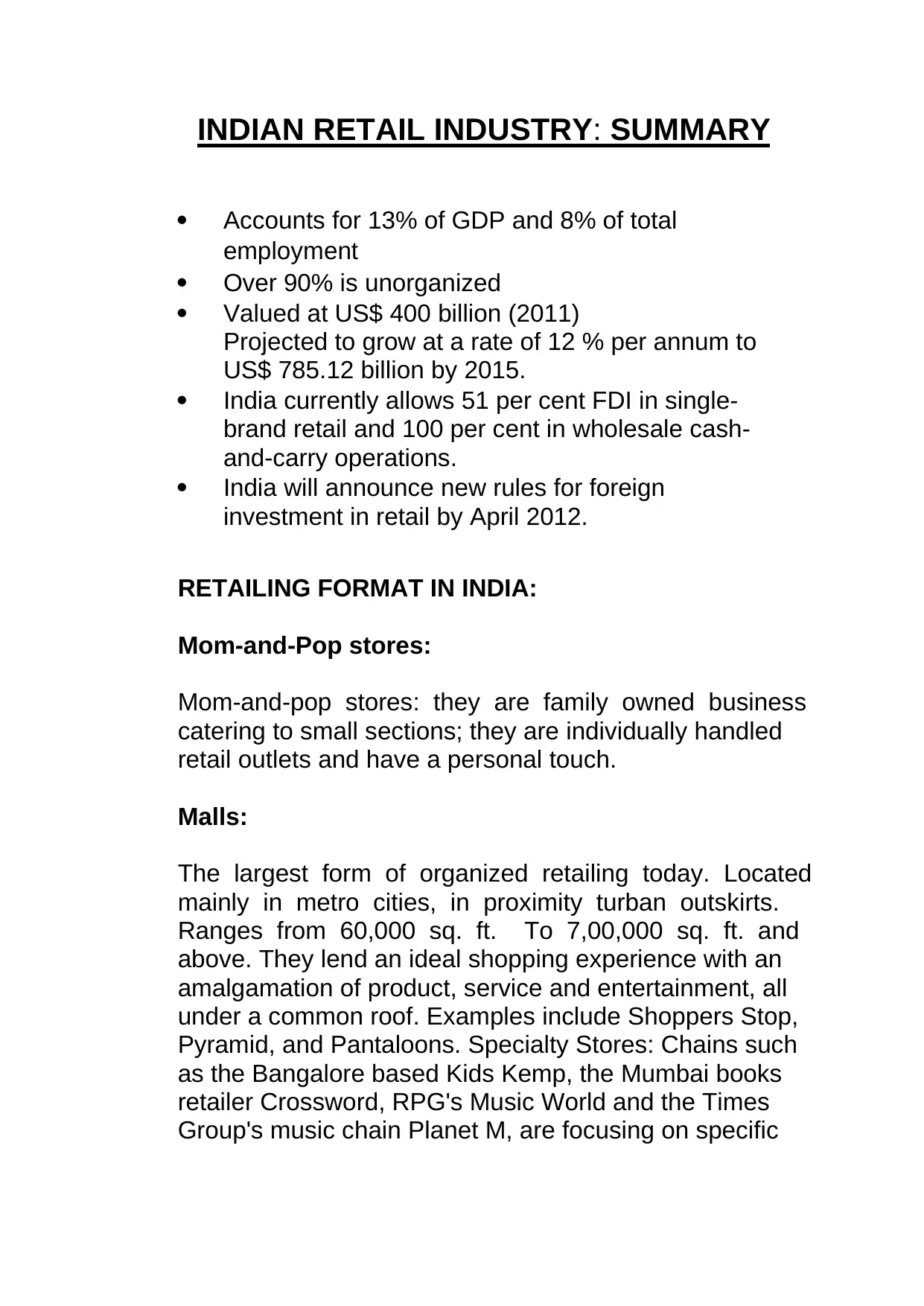
INDIAN RETAIL INDUSTRY: SUMMARY
Accounts for 13% of GDP and 8% of total
employment
Over 90% is unorganized
Valued at US$ 400 billion (2011)
Projected to grow at a rate of 12 % per annum to
US$ 785.12 billion by 2015.
India currently allows 51 per cent FDI in single-
brand retail and 100 per cent in wholesale cash-
and-carry operations.
India will announce new rules for foreign
investment in retail by April 2012.
RETAILING FORMAT IN INDIA:
Mom-and-Pop stores:
Mom-and-pop stores: they are family owned business
catering to small sections; they are individually handled
retail outlets and have a personal touch.
Malls:
The largest form of organized retailing today. Located
mainly in metro cities, in proximity turban outskirts.
Ranges from 60,000 sq. ft. To 7,00,000 sq. ft. and
above. They lend an ideal shopping experience with an
amalgamation of product, service and entertainment, all
under a common roof. Examples include Shoppers Stop,
Pyramid, and Pantaloons. Specialty Stores: Chains such
as the Bangalore based Kids Kemp, the Mumbai books
retailer Crossword, RPG's Music World and the Times
Group's music chain Planet M, are focusing on specific
Accounts for 13% of GDP and 8% of total
employment
Over 90% is unorganized
Valued at US$ 400 billion (2011)
Projected to grow at a rate of 12 % per annum to
US$ 785.12 billion by 2015.
India currently allows 51 per cent FDI in single-
brand retail and 100 per cent in wholesale cash-
and-carry operations.
India will announce new rules for foreign
investment in retail by April 2012.
RETAILING FORMAT IN INDIA:
Mom-and-Pop stores:
Mom-and-pop stores: they are family owned business
catering to small sections; they are individually handled
retail outlets and have a personal touch.
Malls:
The largest form of organized retailing today. Located
mainly in metro cities, in proximity turban outskirts.
Ranges from 60,000 sq. ft. To 7,00,000 sq. ft. and
above. They lend an ideal shopping experience with an
amalgamation of product, service and entertainment, all
under a common roof. Examples include Shoppers Stop,
Pyramid, and Pantaloons. Specialty Stores: Chains such
as the Bangalore based Kids Kemp, the Mumbai books
retailer Crossword, RPG's Music World and the Times
Group's music chain Planet M, are focusing on specific
Paraphrase This Document
Need a fresh take? Get an instant paraphrase of this document with our AI Paraphraser
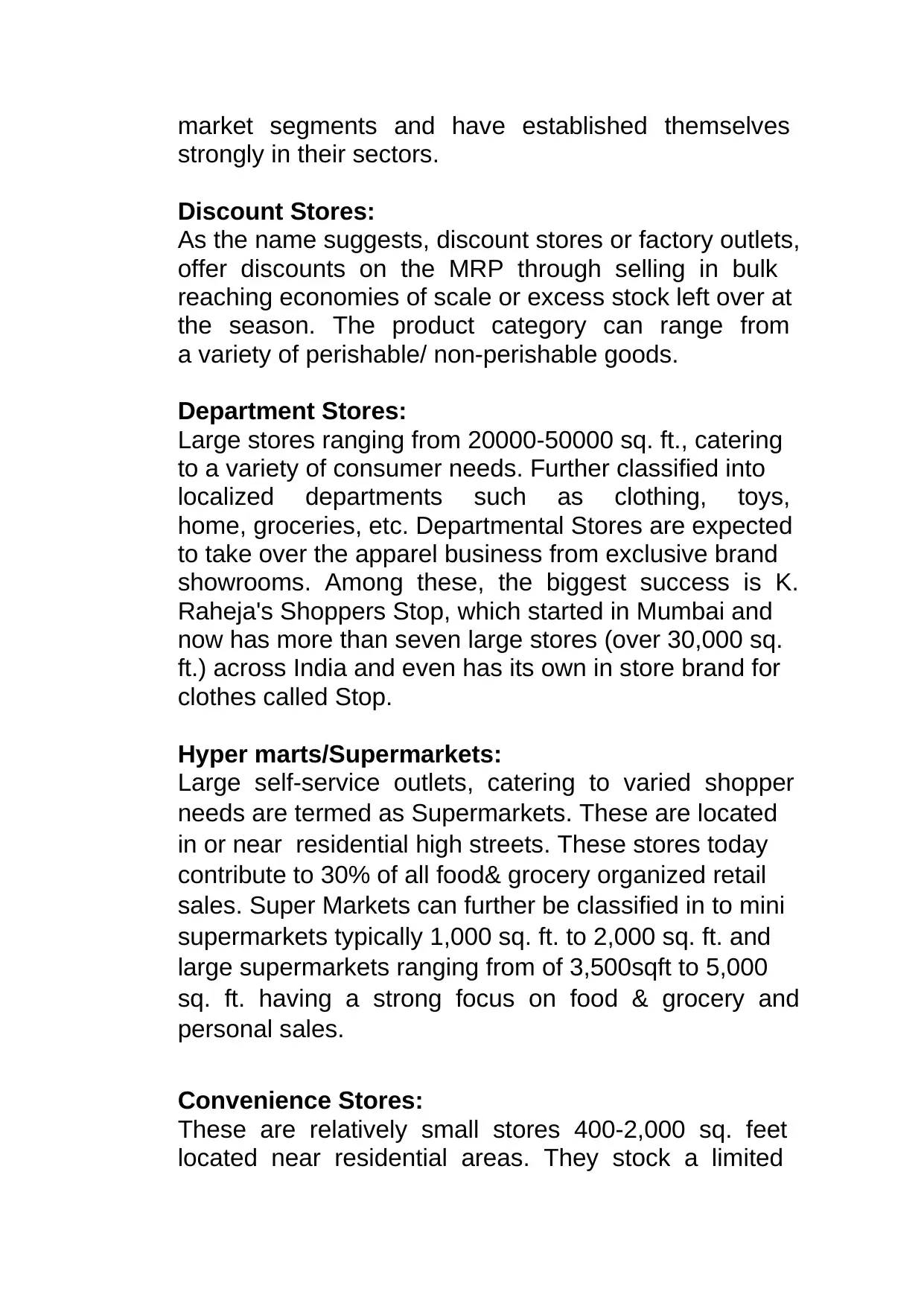
market segments and have established themselves
strongly in their sectors.
Discount Stores:
As the name suggests, discount stores or factory outlets,
offer discounts on the MRP through selling in bulk
reaching economies of scale or excess stock left over at
the season. The product category can range from
a variety of perishable/ non-perishable goods.
Department Stores:
Large stores ranging from 20000-50000 sq. ft., catering
to a variety of consumer needs. Further classified into
localized departments such as clothing, toys,
home, groceries, etc. Departmental Stores are expected
to take over the apparel business from exclusive brand
showrooms. Among these, the biggest success is K.
Raheja's Shoppers Stop, which started in Mumbai and
now has more than seven large stores (over 30,000 sq.
ft.) across India and even has its own in store brand for
clothes called Stop.
Hyper marts/Supermarkets:
Large self-service outlets, catering to varied shopper
needs are termed as Supermarkets. These are located
in or near residential high streets. These stores today
contribute to 30% of all food& grocery organized retail
sales. Super Markets can further be classified in to mini
supermarkets typically 1,000 sq. ft. to 2,000 sq. ft. and
large supermarkets ranging from of 3,500sqft to 5,000
sq. ft. having a strong focus on food & grocery and
personal sales.
Convenience Stores:
These are relatively small stores 400-2,000 sq. feet
located near residential areas. They stock a limited
strongly in their sectors.
Discount Stores:
As the name suggests, discount stores or factory outlets,
offer discounts on the MRP through selling in bulk
reaching economies of scale or excess stock left over at
the season. The product category can range from
a variety of perishable/ non-perishable goods.
Department Stores:
Large stores ranging from 20000-50000 sq. ft., catering
to a variety of consumer needs. Further classified into
localized departments such as clothing, toys,
home, groceries, etc. Departmental Stores are expected
to take over the apparel business from exclusive brand
showrooms. Among these, the biggest success is K.
Raheja's Shoppers Stop, which started in Mumbai and
now has more than seven large stores (over 30,000 sq.
ft.) across India and even has its own in store brand for
clothes called Stop.
Hyper marts/Supermarkets:
Large self-service outlets, catering to varied shopper
needs are termed as Supermarkets. These are located
in or near residential high streets. These stores today
contribute to 30% of all food& grocery organized retail
sales. Super Markets can further be classified in to mini
supermarkets typically 1,000 sq. ft. to 2,000 sq. ft. and
large supermarkets ranging from of 3,500sqft to 5,000
sq. ft. having a strong focus on food & grocery and
personal sales.
Convenience Stores:
These are relatively small stores 400-2,000 sq. feet
located near residential areas. They stock a limited
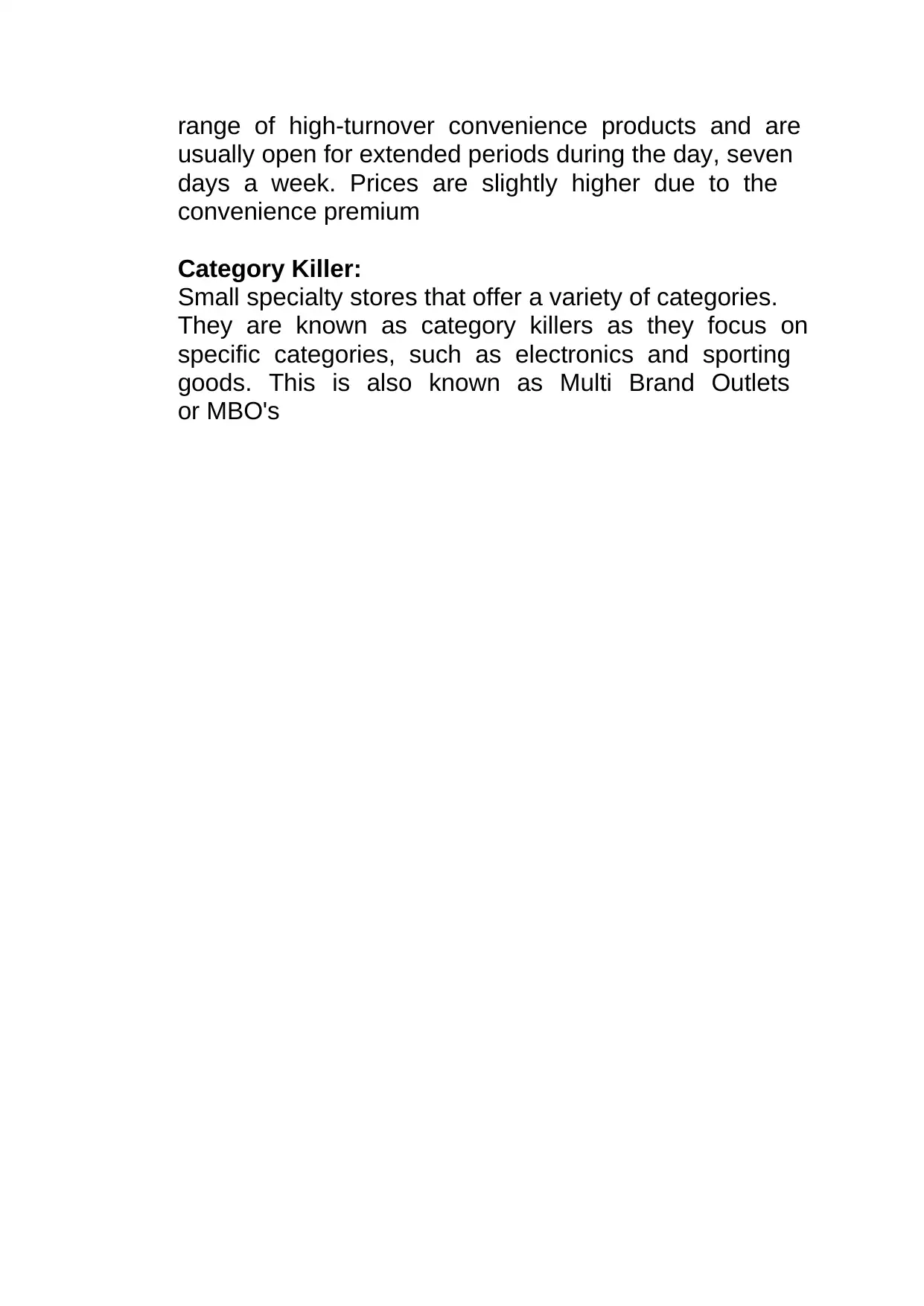
range of high-turnover convenience products and are
usually open for extended periods during the day, seven
days a week. Prices are slightly higher due to the
convenience premium
Category Killer:
Small specialty stores that offer a variety of categories.
They are known as category killers as they focus on
specific categories, such as electronics and sporting
goods. This is also known as Multi Brand Outlets
or MBO's
usually open for extended periods during the day, seven
days a week. Prices are slightly higher due to the
convenience premium
Category Killer:
Small specialty stores that offer a variety of categories.
They are known as category killers as they focus on
specific categories, such as electronics and sporting
goods. This is also known as Multi Brand Outlets
or MBO's
⊘ This is a preview!⊘
Do you want full access?
Subscribe today to unlock all pages.

Trusted by 1+ million students worldwide
1 out of 36
Your All-in-One AI-Powered Toolkit for Academic Success.
+13062052269
info@desklib.com
Available 24*7 on WhatsApp / Email
![[object Object]](/_next/static/media/star-bottom.7253800d.svg)
Unlock your academic potential
Copyright © 2020–2025 A2Z Services. All Rights Reserved. Developed and managed by ZUCOL.